Trending
Opinion: How will Project 2025 impact game developers?
The Heritage Foundation's manifesto for the possible next administration could do great harm to many, including large portions of the game development community.
Motoi Okamoto was a member of Shigeru Miyamoto's Entertainment Analysis and Development department for a decade. He recounts the making of many of Nintendo's best-loved (and biggest-selling) titles.

Motoi Okamoto is the founder of the game developer Entersphere, which produced titles like Army Corps of Hell for PlayStation Vita. He's also a Gamasutra blogger. But from 1999 to 2008, he participated in the development of some of Nintendo's best-loved (and biggest-selling) titles as a programmer, then a script writer and game designer, in Shigeru Miyamoto's Entertainment Analysis and Development (EAD) department.
During his decade at Nintendo, Okamoto had a hand in creating Pikmin, Super Mario 64 DS, Wii Play, and Wii Fit. With each new game, he was one of the first designers to explore the possibilities of new input methods like the touch screen, motion controls, and balance board. In this exclusive interview with Gamasutra, Okamoto speaks about his experiences at EAD, some of the design lessons he learned there, and some fascinating behind-the-scenes tales of working with the minds behind Mario. (Remarks have been edited for space and clarity.)
My experience at Nintendo was a golden time in my game design life, and I'm grateful to my old boss – the grand master, Miyamoto – and to my many colleagues.
In Japan, major companies including Nintendo prefer to hire new graduates over mid-career workers. Those companies don't need a work-ready candidate, but a graduate rich in potential. This is because they believe that they should give new employees proper training on their own. This is the unique employment environment and industry culture of Japan, and Nintendo, probably even now, is an old-fashioned Japanese company.
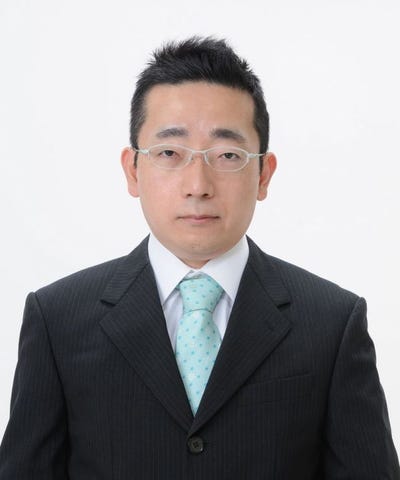
Let me explain the background. Since Nintendo was battling Sony's PlayStation, the company tried to increase the number of excellent new graduates with knowledge of mathematics and physics, a trend that continues today. As long as those new graduates had a solid knowledge of mathematics and physics, they didn't necessarily need to know programming.
In my case, fortunately, I had both the knowledge and 3D programming experience. In my university days, I worked as an intern at a game company called AUN Entertainment, which was funded by a Nintendo joint venture called Marigul.
Any new programming candidates who were assigned to EAD, the development department that Shigeru Miyamoto managed, had to get trained in 3D programming. Sometimes this training would consist of learning to display and animate a 3D model of Mario.
Some of us then participated in a project that EAD was advancing called JSYSTEM. EAD managers thought that they should build a common development environment, including middleware, engines, and tools for all EAD game titles (which included Mario and Zelda) so that they could be sure of completing these very important titles on schedule.
"Nintendo didn't think about putting out high-performance HD game machines like PlayStation 3 or Xbox 360. Knowing that, I decided to switch jobs from graphic programmer to full-time game designer."
At that time, other middleware like Renderware began to become available, but most Japanese game companies chose to build in-house engines and tools on their own. Eventually there were about 15 people working on JSYSTEM. When its development was almost complete, I started to spend some time researching new technologies, like "fur shading" – a designer who had seen the fur effects in Rare's Star Fox Adventures came in and said to the in-house technology group, "We want to do that, too, so can't you do it?"
Fortunately (or not), after the GameCube, Nintendo didn't think about putting out high-performance HD game machines like PlayStation 3 or Xbox 360. Knowing that, I decided to switch jobs from graphic programmer to full-time game designer.
The performance of Wii was roughly twice that of GameCube, so we could keep using JSYSTEM up through The Legend of Zelda: Twilight Princess. (I don't know what Skyward Sword used.) When the Nintendo DS came out, the JSYSTEM development team switched over to creating development environments for both first and third parties.
"My first impression was that the Nintendo was, surprisingly, a big traditional Japanese company. Even the software development staff wore a company uniform like the ones the workers wore in the factory."
My first impression after entering Nintendo was that the company was, surprisingly, a big traditional Japanese company. There were many elderly employees who had been working there before they had ever launched their first video game console. All employees had to submit a daily report on paper every day, in 1999, when each of us had a PC on our desk!
Even the software development staff wore a company uniform like the ones the workers wore in the factory. Of course, I had known in advance that the company was old-fashioned, but when I actually experienced it, it was older-fashioned than I had imagined. But within that old-fashioned organization, the development studios pursued their own unique rationality, such as the development of JSYSTEM.
A few years after I joined, our president Hiroshi Yamauchi stepped down in favor of the young president Satoru Iwata. He would dramatically reform the old Nintendo, analyzing the problems of the company one by one.
First, he moved a part of EAD into a different department that was called SPD. That was the team that created development environments, and which also worked together with overseas game studios. In this way, he created an environment such that Miyamoto could concentrate on only his studio's titles.
Second, he promoted personnel changes and information exchanges between departments in the company. Believe it or not, members of the departments that developed Game Boy Advance games did not know the technical detailed specifications of GameCube, and vice versa. I'm not kidding.
Like the great warlord Oda Nobunaga, Yamauchi wanted his vassals to compete with each other. Nintendo once had three hardware development departments plus EAD. Each of these three departments had its own game development team, and Yamauchi made the leaders of these departments compete with each other. This resulted in successes like the Nintendo Entertainment System and Game Boy, but the departments never shared information with each other.
"Like the great warlord Oda Nobunaga, Yamauchi wanted his vassals to compete with each other. Iwata reformed many parts of Nintendo, but tried to utilize and activate the good old parts as well."
EAD occupied a special position in the company. If one of our game consoles didn't sell well, the divisions would criticize EAD, saying that the failure was because it couldn't create a home-run hit piece of software. My old boss Miyamoto has continued to bear the responsibility of home-run hitter, especially since the days of the Nintendo 64.
Iwata reformed many parts of Nintendo, but tried to utilize and activate the good old parts as well. This was a good decision. One of the reasons is that he was originally an employee of another company, and had not worked at Nintendo before. Old-fashioned Japanese firms trust and love the members who have worked there for many years. "Who is Iwata?" the older members would ask.
However, he had his comrades in the game development teams, who had worked together with him for a much longer time since he was an excellent programmer at HAL Laboratories, which had worked closely with Nintendo on game designs. As president, he needed to increase the number of comrades who agreed with him and calm those who didn't.
This was the hardest game Iwata ever played, but he beat it. I think that Yamauchi had a great genius for picking up talents. Remember that it was him who discovered both Gunpei Yokoi and Shigeru Miyamoto.
Nintendo did not look for game design expertise when it hired new graduates. Of course, when hiring someone who was mid-career, they looked for an expert. But as new graduates, we were employed as programmers or artists, and then some of us changed our jobs to "planner," which is a game designer or level designer. Many famous creators in the company took that path. It gives you an advantage. By following such a career path, the game designer would necessarily have either expert knowledge of programming or skill in art.

Pikmin
In EAD, staff members from other teams will often jump into other projects as needed. So even a 3D graphics expert had the chance to participate in other projects. Before I entered the company, some excellent level designers started in Super Mario Club, the QA department. So while Nintendo is certainly old-fashioned, they had a good culture in that respect.
When developing Pikmin, Miyamoto said "The next Mario is Pikmin."
Remember that Nintendo released neither Mario nor Zelda for the GameCube's console launch. Speaking from the standpoint of a new employee of the time, Pikmin was a game that reflected the Big Boss' conflicts about where his game designs should go. You lead 100 Pikmin to solve a puzzle-like level in a beautiful natural environment with a 30-day time limit. It's a very unique type of game experience, but on the other hand, the gameplay feels classic. That's the idea.

Pikmin
When he was developing Pikmin, Miyamoto was facing two problems, ones that arose with the success of certain titles on the Sony PlayStation. First: should his studio make games that felt like movies, or included pre-rendered movie scenes? At the time, his answer was basically "No." (But in 2014, he created the Pikmin animated shorts.)
Second, how to deal with the phenomenon of "interactive art"? As he's mentioned in many interviews, Miyamoto has long been interested in interactive play and creation tools, not just pure videogames. When game consoles like PlayStation and Nintendo 64 introduced 3D visuals, he considered that perhaps these consoles could also introduce fun interactive art that players could continue to touch and play without a clear goal, or creative tools.
"Pikmin reminds me of interactive-art environment games like Cubivore and Doshin the Giant. But the game design god Miyamoto introduced classic game mechanisms into it."
Remember that Miyamoto had produced the Mario Artist series in 1999, a series of creative titles that were only released in Japan since they were created for the Nintendo 64DD. And there were two other 64DD projects that struck a balance between interactive art and traditional videogame – Cubivore: Survival of the Fittest and Doshin the Giant.
Cubivore was designed by Gento Matsumoto, the creator of the PlayStation game Jungle Park. Doshin the Giant was designed by Kazutoshi Iida, creator of Aquanaut's Holiday and Tail of the Sun. Both of these creators made interactive-art-like video games. These were both eventually moved to the GameCube.
From that point of view, Pikmin reminds me of those interactive-art environment games. But the game design god Miyamoto introduced classic game mechanisms into it. I think that's his long-standing conflict: He has the large responsibility of making killer titles that sell consoles, and of course he is a great magician with plenty of techniques to build classic game mechanics and tight gameplay. But he also wants to create open-ended play.
I understand what Miyamoto meant when he said "the next Mario is Pikmin." Pikmin was his launch title for GameCube, and is now seen as one of his masterpieces. He'd created a great game with Mario, and was trying to again create the next big thing in games.
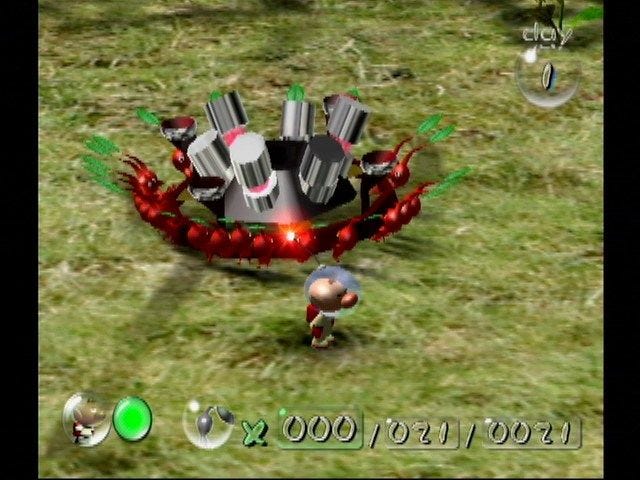
Pikmin
Of course, Miyamoto also tackled this game-versus-play conflict with the development of Nintendogs, a game without a goal that had more freedom of play than Pikmin. Of course, it also has three "contests" – Disc Competition, Agility Trial, and Obedience Trial, which are traditional gameplay, the compromise he made with himself.
I think that the great maestro will continue to consider where his work will go. Due to the advancement of the technology and growth of the staff, his balance could lean towards something other than traditional video games. If he were to introduce the Physics Engine and Chemistry Engine of Zelda: Breath of the Wild into Pikmin, it could be reborn into a completely different game.
Miyamoto's involvement with Pikmin 2 was less than with the first Pikmin, since he had to work on other titles. Two directors, Shigefumi Hino and Masamichi Abe, greatly reformed Pikmin's game design, eliminating the 30-day time limit and adding the new Purple and White colors of Pikmin. They also added many dungeons to explore, and a large amount of collectible objects.
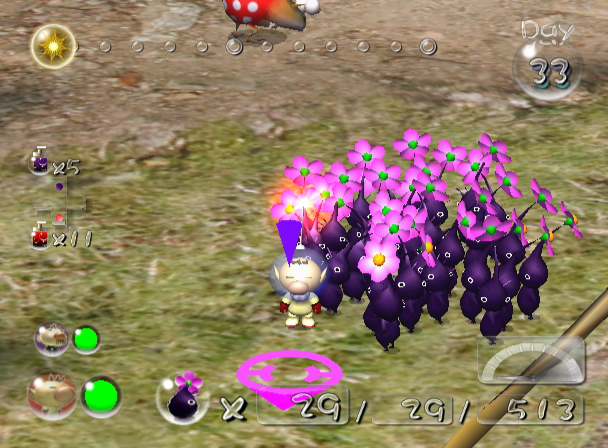
Pikmin 2
Hino directed the visual, atmosphere, background setting, and play feel of the game, and Abe rebuilt the game mechanics and directed the level design of all dungeons. They probably tried to bring Pikmin closer to an RTS-like game. At least, they succeeded in greatly extending the enjoyable playing time.
The development team experienced a postponement due to lack of quality, but the experience of reforming a game was valuable. It was a good experience.
"My experience during this game's development made me want to create a Mario platformer played only with a stylus. But I never got the chance."
I am glad that my big first step as a game designer was that work.
When I began, I first thought that I should research and analyze the game mechanics of point-and-click games, so I played lots of Flash games. Lots.
I made games where you had to move the cursor around and could easily touch one of multiple objects. Then I tried to increase the number or the complexity of those objects. I realized that if you were watching many objects that looked similar, or if they were moving, that would be a game that tested your cognitive abilities.
The following mini-games of Super Mario 64 DS reflected these thoughts:
Wanted: You hunted for a target character in a crowd.
Which Wiggler?: You choose the correct Wiggler out of a group of them that are sleeping or moving around.
Boom Box: A sound-based version of the card-matching "Memory" game.
Intense Coincentration: Watch many falling coins.
Next, I focused on games where touching or drawing lines would change the situation. In Bounce and Pounce, you touch three falling Marios, making them jump in order to step on Fly Guys. Essentially, it is similar to juggling, but unlike juggling balls, Mario can do fun motions in the air. The same goes for Trampoline Time, where you draw lines that turn into trampolines. In Snowball Slalom, sliding and rolling snowballs will get bigger and bigger.
Super Mario 64 DS
I also added funny mini-games that were not pure games. I thought the touch screen, being easy to play with one hand, would broaden the gaming audience. I added Loves Me…?, in which a player pulled petals off a flower for fortune-telling, and Psyche Out! based on Zener ESP cards. I arranged the variety of gameplay carefully, planning the ratio of casino games to action games to puzzle games to cognitive test games, and so on.
"Miyamoto would come to us at 11 PM, after he finished all of his board-member work, and say, 'It's Mario time.' At that point, we'd start a planning meeting that would run until 2 AM."
My experience during this game's development made me want to create a Mario platformer played only with a stylus. But I never got the chance.
In those days, Miyamoto would come to us at 11 PM, after he finished all of his board-member work, and say, "It's Mario time." At that point, we'd start a planning meeting that would run until 2 AM. At that point, Miyamoto would go home, leaving us with the words, "You should return home soon, for your health." Over the next two or three hours, we'd write the game design documents and summarize the instructions for our artists and programmers.
It was the craziest crunch time that I've ever experienced in my development career. But if the God of Games was working so much, could we give up? Miyamoto had incredible stamina.
Lacking an analog stick, Super Mario 64 DS was an incomplete 3D Mario game, so Miyamoto wanted to try to improve it. We added three extra stages and the ability to play as four characters: Mario, Luigi, Yoshi, and Wario. Yoshi could hover in the air, which helped to relax the difficulty of jumping around in the 3D world.
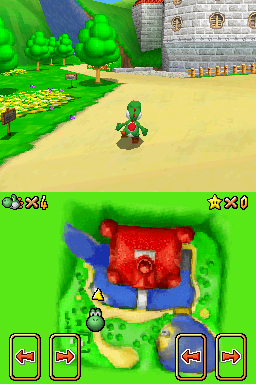

Personally, it was a pleasant experience to get to hear Mario 64's design philosophy directly from Miyamoto, since it was Super Mario 64 that made me want to become a game developer.
Wii Play, Wii Sports, Wii Fit, and Wii Music were all part of Miyamoto's connected "Wii Project." One day, Miyamoto gathered producers and directors in EAD and showed us how we were going to group together and sell the various prototypes that used the Wii Remote. We had only 7 or 8 months left to the development deadline!
The sporty prototypes where you moved the Wii Remote with big motions were rolled up with the theme of "Sports." The prototypes where you used the Wii Remote as a pointing device, as well as other small prototypes, were included in the other package, Wii Play.

Wii Play
Wii Music's "Mii Maestro" was originally planned to be included in Wii Play. But after E3, EAD producers concluded that it would be better to separate it into a different package of "Music."
What's the difference between touch pen and Wii Remote pointing? The difficulty of aiming with a pointer. The touch pen directly touches the screen, but the Wii Remote just points at the screen from far away. So with Wii, simply aiming can be playing. That's Shooting Range. And Find Mii is Mario 64 DS' Wanted, reborn. Because there were so many variations in the faces of Mii characters, I thought this would be more interesting than choosing from the faces of Mario, Luigi, Wario, and Yoshi.
Unlike a touch pen, the Wii Remote knew if you were rotating it, which is applied to the games Pose Mii and Laser Hockey. It is also able to judge pseudo-movement in the depth direction. Table Tennis, Fishing, and Billiards used such technology. For Billiards, I wanted to create an enjoyable game that could be played slowly.
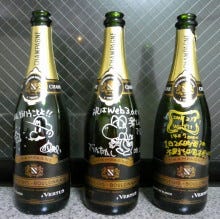
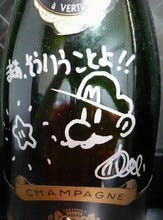
Out of privacy concerns, Okamoto couldn't provide pics of his former Nintendo colleagues. But he sent along photos of a signed champagne bottle given to him by Miyamoto at his farewell party.
Yes, there were two. Both were side-view scrollers. One was called Obstacle Course, which was seen at the 2006 E3. Another was a side-view flight action game called Bird. My team didn't have enough time to brush them up. The team was very small, and the Wii Play team shared artists and system programmers with the Wii Sports team. As the working time of artists for Wii Sports increased, the work time for Wii Play decreased. And it was clear that the company should give priority to Wii Sports.
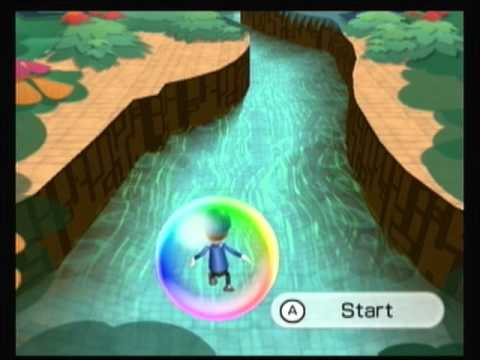
Wii Fit
Later, I adopted the level design of Obstacle Course into Wii Fit's Balance Bubble. I turned the course layout for the side scroll 90 degrees, making it a course that went lengthwise. As the team was small, I tried not to waste anything. Later, I found Bird in another form in the Wii U game Nintendo Land, as Balloon Trip Breeze.
In my career I've had many chances to work on launch titles for new consoles or accessories: Super Mario 64 DS, Wii Play, Wii Fit, and also Army Corps of Hell for the PlayStation Vita.
By the time I made Wii Fit, I was already a veteran mini-game designer. But this was the most difficult mission. As you point out, no, it's not a traditional game. In that sense, it was the most extreme "non-video game" produced by the Big Boss Miyamoto. (Of course, we all knew that there would be Wii Music following Wii Fit.)
"Early in development, the Wii Balance Board was square-shaped, like a bathroom scale. But one day, when I demonstrated the push-ups game using a scale in front of Miyamoto, he said, 'Okamoto, who doesn't exercise, is trying to do push-ups. This is hilarious!' But this is how the square-shaped balance board became oblong, to accommodate a man's shoulder width, so players could use it for push-ups."
Once again, I started by analyzing what the new device would make possible. In other words, what kind of information can we acquire via the Balance Board? The answer was simple: It was the same as an analog stick, with X and Y coordinates. So I thought that it would be a good idea to think of games that used a "human analog stick". (Please imagine this situation. It's very funny.)
You spin the analog stick around? That's Hula Hoop.
Push the stick and release it? Ski Jump.
Operate the stick delicately? Balance Bubble.
In addition, I imagined that many users would expect "sporty play" in the Wii series, so I arranged some games like Soccer Heading, Rhythm Boxing, Ski Jump, Slalom, Snowboard Slalom, and so on. Coincidentally, there were so many winter sports that we joked that we should change the name of the game to "Wii Winter Sports."
Early in the game's development, the Wii Balance Board was square-shaped, just like an ordinary bathroom scale. But one day, when I demonstrated the push-ups game using a scale in front of Miyamoto, he smiled broadly and said, laughing, "Okamoto, who doesn't exercise, is trying to do push-ups. This is hilarious."
The way Miyamoto was watching the spectacle of me trying to do push-ups was just like how all the members of the family would eventually gather around and watch Wii Fit at home. Just watching your family do training is funny. But this is how the square-shaped balance board became oblong, to accommodate a man's shoulder width, so players could use it for push-ups.
When we demonstrated the mini-games Strength Training and Yoga to Miyamoto, the game did not display the current 3D mannequin-like Wii Fit Trainer, but a live-action video of a trainer. We shot it with a hand camera, just for reference. I edited a sequence of video on a PC for the prototype, and asked the programmer to display a radar map showing the position of the player's center of gravity.
Miyamoto had said that we should use live-action video for Wii Fit, because he felt that the fine gestures of the live-action trainer would be important. But the artists pushed for the 3D modeled trainer, because we knew about Miyamoto's propensity to "upend the tea table" and change everything around on us. A 3D model could be changed much more easily than a video!
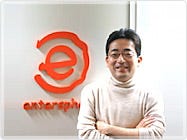 We laid yoga mats on the floor of our office and did yoga repeatedly every day, and took up jogging. That was a strange development process. Other team staff members that passed by were always smiling at us! It was a strange and fun experience.
We laid yoga mats on the floor of our office and did yoga repeatedly every day, and took up jogging. That was a strange development process. Other team staff members that passed by were always smiling at us! It was a strange and fun experience.
Recently, I went to one of Konami's gyms for several months and dropped 10 kilograms. So I might be able to create another piece of software for fitness and exercise now. So if any publishers out there are interested, let me know (laughs).
You May Also Like